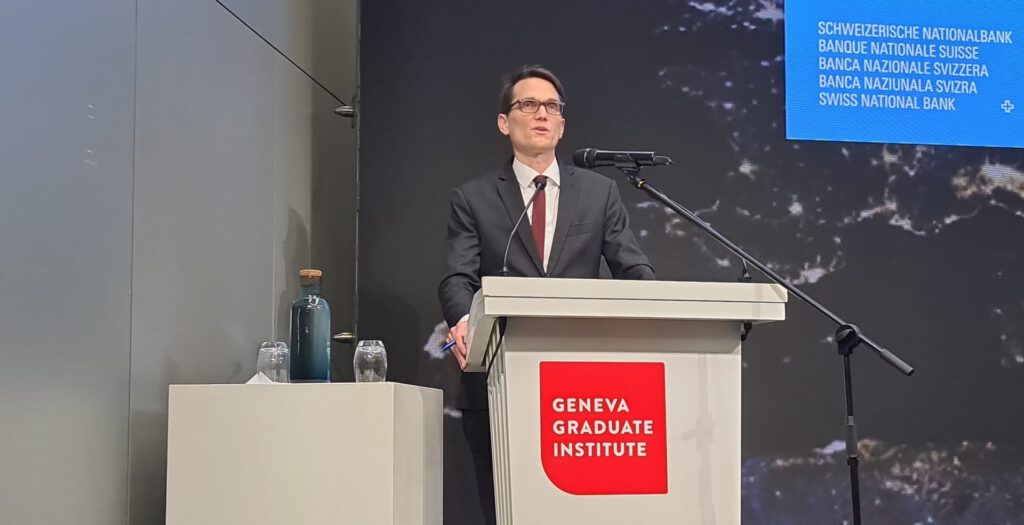
Martin Schlegel, the crown favorite to become head of the SNB, defends interventions on the market. He says they are essential for stable prices.
Martin Schlegel, the frontrunner for the post of head of the Swiss National Bank (SNB), has reaffirmed the need for central bank intervention in the foreign exchange market.
Without these interventions by the central bank on the capital market, the mandate to ensure price stability could not have been fulfilled.
The Vice-Chairman of the SNB Governing Board said this at a public lecture at the International Center for Monetary and Banking Studies (ICMB) in Geneva this Tuesday evening.
Crashing global economy
For decades, the exchange rate has played an important role for the Swiss economy and for the SNB’s monetary policy.
But it was only during the global financial crisis, back in March 12, 2009, that the Swiss central bank began to intervene on the foreign exchange market on a large scale, Schlegel continued.
Just six months before that date, Lehman Brothers had filed for bankruptcy.
Stock markets collapsed, the global economy plummeted, and inflation fell. Central banks around the world rapidly lowered their key interest rates and increased liquidity.
Deflation fight as trigger
The turbulence on the international financial markets also reached the Swiss financial market. The decline in global demand hit the Swiss economy.
Investors fled to the Swiss franc, which was considered a safe haven, putting the currency under strong upward pressure.
The inflation outlook deteriorated and the risk of deflation became acute, prompting the SNB to lower its key interest rate to 0.25 percent.
Pours out its heart
“But even with the key interest rate close to zero, monetary conditions would still have been too restrictive,” said Schlegel. Further measures were therefore necessary, he continued, who was head of the Foreign Exchange and Gold organizational unit at the time, in front of dozens of students in Geneva.
“The topic of foreign exchange market interventions is therefore close to my heart,” he emphasized.
However, unlike other central banks, the SNB was unable to buy sufficient quantities of bonds to ease monetary policy. This was because the Swiss franc bond market was far too small.
The SNB therefore intervened in the foreign exchange market. “In this way, we tackled the main cause of the deflation risk – the appreciation of the franc – directly.”
Minimum exchange rate fixed
The global financial crisis was followed by the European sovereign debt crisis in 2010 and intensified massively in the summer of 2011. The Swiss franc came under strong upward pressure and almost reached parity with the euro.
Between the beginning of the global financial crisis in summer 2007 and summer 2011, it had appreciated by almost 40 percent against the euro, which is why the risk of deflation was once again high.
Due to this risk and the threat to the Swiss economy, the SNB introduced a minimum exchange rate of 1.20 Swiss francs per euro.
“We were prepared to buy an unlimited amount of foreign currency to enforce this minimum exchange rate,” said Schlegel about the renewed activities on the foreign exchange market.
Different monetary policies
The measure proved to be effective and stabilized inflation in the medium term. In addition, planning certainty for companies has improved and the economy has developed robustly as a result.
According to Schlegel, the capital markets anticipated that the direction of monetary policy in the USA and the eurozone would develop differently in 2014.
They expected a tightening of monetary policy in the USA. At the same time, the European Central Bank signalled that further monetary easing measures would be necessary at the end of 2014.
The diverging monetary policy outlook influenced exchange rates: The euro depreciated significantly against the US dollar, causing the Swiss franc to weaken against the US dollar.
“The Swiss franc exchange rate approached 1.20 Swiss francs per euro and we had to intervene in order to maintain the minimum exchange rate set by the SNB,” explained Schlegel.
Loss of control over balance sheet
In this environment, the minimum exchange rate would no longer have been sustainable. Maintaining it would have entailed high costs: even more extensive interventions, loss of control over the SNB’s balance sheet and loss of credibility.
The SNB therefore decided to discontinue the minimum exchange rate on January 15, 2015. At the same time, it lowered the key interest rate to -0.75 percent.
The first nominal appreciation in January 2015 was considerable after the “shock”.
However, negative interest rates and foreign currency purchases cushioned the appreciation and deflation to a certain extent in the following months.
Export industry suffered badly
Export-oriented companies, in particular, were negatively affected by the sudden appreciation of the Swiss franc. Many companies were able to absorb the shock by reducing their profit margins. In the long term, however, they had to tweak their cost base.
“After the minimum exchange rate was lifted, we continued to be active on the foreign exchange market,” said Schlegel.
The SNB no longer focused solely on the euro, but on the entire currency situation, so that the Swiss franc did not become immeasurably more expensive.
Currency sales against inflation
Towards the end of the coronavirus pandemic, energy prices skyrocketed, as Schlegel recalled. Global supply chains were disrupted. At the same time, household consumption normalized with the lifting of lockdowns. But the war in Ukraine exacerbated the situation again.
Inflation rates rose sharply worldwide, including in Switzerland, but later and less markedly than in other countries.
Rising import prices, especially for energy, were initially the strongest drivers of inflation in Switzerland.
In order to curb imported inflation, the SNB ended its foreign currency purchases and allowed the Swiss franc to appreciate.
No alternative
In June 2022, it then raised the SNB key interest rate by 50 basis points to -0.25 percent. During the fourth quarter of 2022, it started selling foreign currency to support the tightening effect of interest rates. In total, it sold around 22 billion Swiss francs worth of foreign currency in 2022.
In 2023, foreign currency sales even amounted to around 133 billion Swiss francs, which corresponded to 17 percent of Switzerland’s gross domestic product (GDP).
The combination of interest rate hikes and currency sales quickly brought inflation down to the price stability range, which the SNB defines as below 2%.
“Without the use of currency sales, the SNB would have had to raise the key interest rate more sharply,” Schlegel continued.
High fluctuations as burden
Schlegel described the large balance sheet as a side effect of the SNB’s monetary policy over the past 15 years. “The SNB has significantly increased its foreign exchange reserves and thus its balance sheet in order to fulfill its mandate.”
In 2022, the SNB balance sheet reached a record value of one trillion Swiss francs. This corresponds to almost one and a half times Switzerland’s GDP.
The larger foreign exchange reserves are also accompanied by greater fluctuations in absolute gains and losses. These fluctuations are primarily dependent on developments on the international financial markets.
“In particular, developments in exchange rates, share prices and interest rates influence our annual result,” says Schlegel.
Risks to the SNB
The SNB then even posted a loss of 132.5 billion Swiss francs and was unable to distribute any profits to the Confederation and cantons.
The SNB’s foreign exchange purchases shifted the currency risks from the private sector to the SNB.
In Schlegel’s view, however, foreign exchange market interventions have helped to maintain price stability over the past 15 years.
Interaction is important
“Through the combination of the key interest rate and foreign exchange market interventions, the SNB has succeeded in ensuring appropriate monetary conditions – both in phases of low inflation and with the SNB key interest rate close to the effective interest rate floor, as well as during periods of high inflation.”
The most recent phase of high inflation showed how well the interplay between interest rate hikes and currency sales worked: inflation was successfully brought back into the realm of price stability.
When asked by muula.ch whether Schlegel considers himself qualified to hold the office of Chairman of the SNB on the basis of this experience, the promising candidate for the position was reserved.
He could not comment on this, he merely said in Geneva. But this is also indirect manipulation.
09.04.2024/mat./ena.






